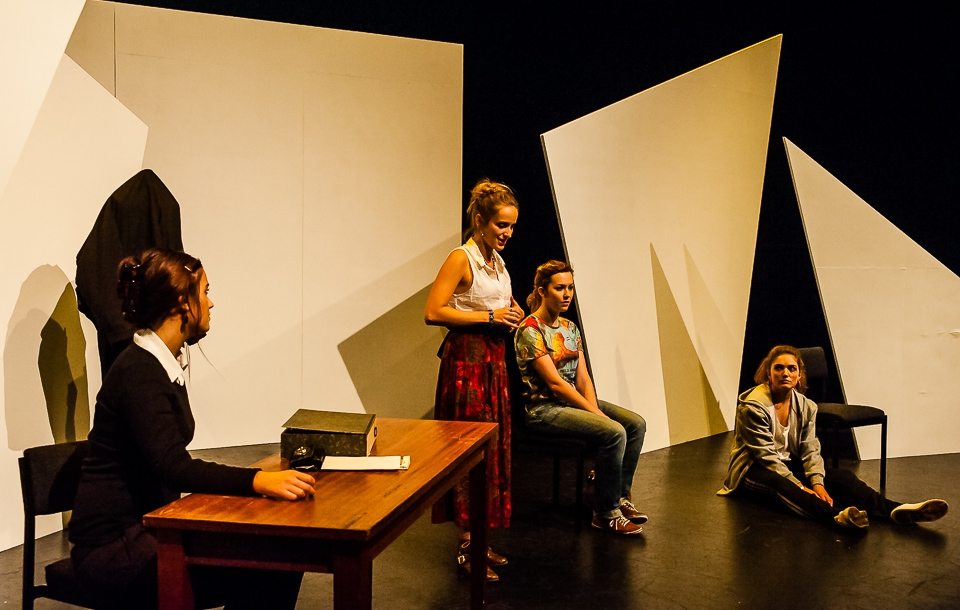The Positive Hour: Review
This powerfully-acted drama from the WUDS is one of the best pieces I have seen at the Arts Centre and not just in terms of student productions. It develops along the theme of the tensions between restraint and violence. What happens when we ignore our own anger, or we are subject to the anger of others? To realise this idea in the physicality of the performances, as directed by Harri Mckenzie-Donovan, the cast focused on the techniques of the practitioner Vsevelod Meyerhold and biomechanics during the rehearsals, allowing the actors to ‘experience a true sense of frustration as they fought against physical constructions and limitations placed upon them.’
April de Angelis’ play looks predominantly at the lives of women affected by these issues raised. It initially centres around Miranda (Bryony Davies), a social worker, and her client, Paula (Rosie Gray) – a single mother. After Paula’s spell in prison her daughter is being fostered by an unseen couple who live an expensive train-ride away and Paula’s part-time work ‘giving men what their wives won’t’ isn’t helping her to get her daughter back.
Nicola (Kitty Murdoch), has a father who is causing problems at home and Murdoch seemed perfectly cast in the role, combining a resilient strength with the vulnerability of a young girl under her father’s smothering gaze. She joins Paula and Emma (Hannah Price) in a group-therapy session, which involves Nicola role-playing her father. This is the only time we ‘see’ him onstage and Murdoch carries it off so effectively that by the end of the play her father seems to have been a main character, despite never actually appearing to any of the other characters. In the second of these role-playing episodes, Murdoch’s performance made Nicola seem to have a split personality, driving home the pain her father causes. This was truly gripping, illustrating the internal conflicts all the characters struggle with.
Bryony Davies’ performance as Miranda was much subtler, presenting her as world-weary, overworked and yet optimistic, and we can understand why Emma is drawn to her as a source of comfort and authority. Eddie Elliott played Roger, Miranda’s painfully middle-class husband who is starting to get uncomfortable with his mid-life status. Elliott presented him as youthful and likeable, but the difference in energy between the husband and wife spoke of trouble from the start. His scenes with Emma towards the end were both hilarious and deeply uncomfortable.
The set, designed by Emma Digby, was a series of angular white boards placed in front of one another at the back of the stage. This created several entrances and exits, allowing the actors to enter and leave unexpectedly. At one point, Roger bounded onto the stage to rock music, from an entrance we’d forgotten about; a hint that there were further surprises to come from his character. Lighting and set combined well to change the mood with colours and strengths of lighting, as well as beginning and ending with a projection of a digital clock; time is running out for just about everyone in this play.
An ivy covered balcony was set at the back of the stage, from which Paula’s daughter (a believably childlike Rebecca Webster) Victoria spoke. Her elevated position above the rest of the cast symbolically separated her from Paula, who seemed to be constantly chasing after a shared life with her daughter and yet distancing herself from her when they were together in person. The characters spoke into thin air when addressing the child, underlining her total absence from Paula’s current and future life.
There was plenty of comedy in this piece, even in unexpected places and often from Paula, which is surprising given her particularly dismal circumstances. Rosie Gray gave us the impression that Paula had become good at papering over the cracks in her life with humour and audacity. Further comedy came from the masked man’s (Harry Wilson) deadpan character played against Hannah Price’s jittery Emma, especially during their first date, when the masked man strolled on in bondage gear, leaving Emma shocked and stuttering about her feminist principles. This initial shock later turns to curiosity though, when she begins to explore S&M as a form of therapeutic relief. Emma’s character development is central to the plot, and Price, whose performance was exceptional, played off the other characters to let different elements of her character surface. As her personality moulded to different situations and characters, the tensions in these relationships and individuals would alter.
The production didn’t offer us clear answers to the questions it posed about the role of violence in society, though Miranda’s refusal to express her emotions fully and then eventual collapse are a clue that she’s not doing things the right way. Instead it gave us enough insight into the characters’ complex, messy, tension-ridden lives to make up our own minds about them. Had they all really just been ‘straightjacketed’ into taking the course they took? The play left it for you to decide.

Comments